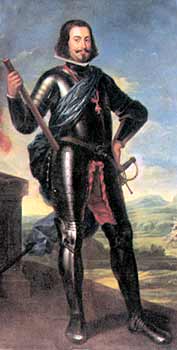<Back to Index>
- Mathematician Jakob Steiner, 1796
- Writer Marie Madeleine Pioche de La Vergne, comtesse de La Fayette, 1634
- King of Portugal and the Algarves João IV o Restaurador, 1603
PAGE SPONSOR

John IV (Portuguese: João IV de Portugal; 18 March 1603 – 6 November 1656) was the King of Portugal and the Algarves from 1640 to his death. He was the grandson of Catherine, Duchess of Braganza, who had in 1580 claimed the Portuguese crown and sparked the struggle for the throne of Portugal. John was nicknamed John the Restorer (João o Restaurador). On the eve of his death in 1656, the Portuguese Empire reached its zenith, spanning almost 3 billion acres.
John was born at Vila Viçosa and succeeded his father Teodósio II as Duke of Braganza when the latter died insane in 1630. He married Luisa de Guzman (1613 – 1666), eldest daughter of Juan Manuel Pérez de Guzmán, 8th Duke of Medina Sidonia, in 1633. He was raised to the throne of Portugal (of which he was held to be the legitimate heir) during the revolution on 1 December 1640, against the Spanish king Philip IV.
His accession led to a protracted war (the Portuguese Restoration War) with Spain, which only ended with the recognition of Portuguese independence in a subsequent reign (1668). Portugal signed alliances with France (1 June 1641) and Sweden (August 1641) but by necessity its only contributions in the Thirty Years' War were in the field against Spain and against Dutch encroachments on the Portuguese colonies.
In Spain, a Portuguese invasion force defeated the Spanish at Montijo, near Badajoz, in 1644. Abroad, the Dutch took Malacca (Jan 1641) and the Sultan of Oman captured Muscat (1650). Nevertheless the Portuguese, despite having to divide their forces among Europe, Brazil and Africa, managed to retake Luanda, in Angola, from the Dutch in 1648 and, by 1654, had recovered most of Brazil, effectively ceasing to be a viable Dutch colony. This was countered by the loss of Ceilan (Portuguese Ceilão), present day Sri Lanka, to the Dutch who took Colombo in 1656. King John IV died in 1656 and was succeeded by his son Afonso VI. His daughter, Catherine of Braganza, married King Charles II of England. John
was a patron of music and the arts, and a considerably sophisticated
writer on music; in addition to this, he was a composer. During his
reign he collected one of the largest libraries in the world, but it
was destroyed in the Lisbon earthquake of 1755. Among his writings is a defense of Palestrina, and a Defense of Modern Music (Lisbon, 1649). His most famous composition is a setting of the Crux fidelis, a work that remains highly popular during Lent amongst church choirs.
John married Luisa de Guzman, daughter of Juan Manuel Pérez de Guzman, 8th Duke of Medina - Sidonia.
From that marriage several children were born. Because some of John's
children were born and died before his father became King they are not
considered infantes (princes) or infantas (princesses) of Portugal.